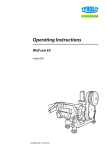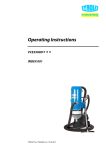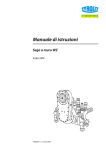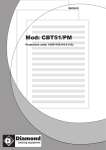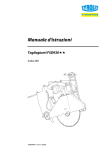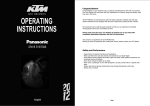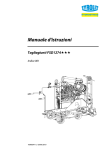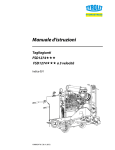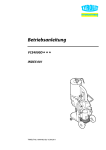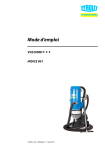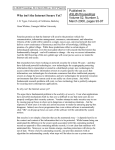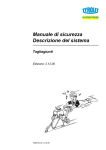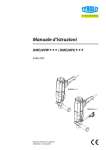Download PDF - Tyrolit
Transcript
Operating Instructions VCE4000D INDEX 001 TYROLIT No. 10991064 en/ 15.04.2011 Congratulations! You have decided to purchase a tried and tested TYROLIT-Hydrostress unit and have thus acquired a highly sophisticated and reliable state-of-the-art unit. The exclusive use of only TYROLIT Hydrostress spare parts ensures quality and interchangeability. If maintenance work is neglected or carried out inexpertly we will be unable to honour our warranty obligations. Any repair work must be carried out by trained personnel only. Should you need more details concerning your TYROLIT Hydrostress unit in order to keep it in perfect condition, please contact our after-sales service for further information. We hope that you enjoy untroubled and fault-free working with your TYROLIT unit. TYROLIT Hydrostress Copyright © TYROLIT Hydrostress TYROLIT Hydrostress AG Witzbergstrasse 18 CH-8330 Pfäffikon Switzerland Telefon 0041 (0) 44 952 18 18 Telefax 0041 (0) 44 952 18 00 Konformitätserklärung Declaration of conformity Dust separator VCE4000 We declare under our sole responsibility that this product complies with the following directives and standards: Directive applied Typenschild hier auf kleben Machinery Directives 2006/42/EC EMV 2004/108/EG NSR 2006/95/EG Applied standards EN 12100-1 EN 12100-2 Safety of machinery – Basic concepts, general design principles. EN 14121-1 Safety of machines - Risk assessment, Part 1: Principles Vibration Regulation ISO 5349-1 / ISO 5349-2 / ISO 20643:2005 Noise Protection Regulation ISO 3741 Déclaration de conformité Staubabscheider VCE4000 Séparateur de poussière VCE4000 Wir erklären in alleiniger Verantwortung, dass dieses Produkt mit den folgenden Richtlinien und Normen übereinstimmt: Nous déclarons, sous notre seule responsabilité, que ce produit répond aux directives et normes suivantes: Angewandte Richtilinie Directive appliquée Maschinen-Richtlinien 2006/42/EG EMV 2004/108/EG NSR 2006/95/EG Directive relative aux machines 2006/42/CE EMV 2004/108/EG NSR 2006/95/EG Angewandte Normen Normes appliquées EN 12100-1 EN 12100-2 Sicherheit von Maschinen-Grundbegriffen, allgemeine Gestaltungsgrundsätze. EN 12100-1 EN 12100-2 Sécurité des machines, notions fondamentales, principes généraux de conception EN 14121-1 Sicherheit von Maschinen-Risikobeurteilung, Teil 1: Leitsätze EN 14121-1 Sécurité des machines - Appréciation du risque - Partie 1 : principes Vibrationsverordnung ISO 5349-1 / ISO 5349-2 / ISO 20643:2005 Lärmschutzverordnung ISO 3741 TYROLIT 10991214 Décret relatif aux vibrations ISO 5349-1 / ISO 5349-2 / ISO 20643:2005 Décret relatif à la protection contre les nuisances sonores ISO 3741 Dichiarazione di conformità CE Abbattitore delle polveri VCE4000 Dichiariamo sotto la nostra completa responsabilità che il presente prodotto è conforme alle seguenti direttive e norme: Direttiva applicata Direttiva Macchine 2006/42/CE EMV 2004/108/EG NSR 2006/95/EG Norme applicate EN 12100-1 EN 12100-2 Sicurezza del macchinario - Concetti fondamentali, principi generali di progettazione EN 14121-1 Sicurezza del macchinario - Valutazione del rischio - Parte: Principi Direttiva Vibrazioni ISO 5349-1 / ISO 5349-2 / ISO 20643:2005 Direttiva Emissione Acustica Ambientale ISO 3741 Declaración de conformidad CE Separador de polvo VCE4000 Declaramos bajo propia responsabilidad que este producto cumple con las siguientes directivas y normas: Directiva aplicada Directiva de Máquinas 2006/42/CE EMV 2004/108/EG NSR 2006/95/EG Normas aplicadas EN 12100-1 EN 12100-2 Seguridad de las máquinas. Conceptos básicos, principios generales para el diseño. EN 14121-1 Seguridad de las máquinas. Evaluación del riesgo. Parte 1: Principios Directiva de vibraciones ISO 5349-1 / ISO 5349-2 / ISO 20643:2005 Directiva sobre emisiones sonoras ISO 3741 TYROLIT Hydrostress AG Witzbergstrasse 18 CH-8330 Pfäffikon Switzerland Pfäffikon, 27.01.2011 Pascal Schmid Leiter Entwicklung Tyrolit VCE4000P 1 2 3 4 Table of contents Introduction 1 1.1 General Information ......................................................... 1.2 Responsibility .................................................................. 1.3 Manual ............................................................................. 1.3.1 Safety instructions – Explanation of symbols ..... 1.4 Transportation ................................................................. 1.5 On delivery ...................................................................... 1.6 Unpacking the dust extractor ........................................... 1.7 Machine name plate ........................................................ 1.8 Handling and storage ...................................................... 1.9 Noise ............................................................................... 1.9.1 Sound pressure level .......................................... 1 1 1 1 2 2 2 2 3 3 4 Safety 5 2.1 General Information ......................................................... 2.2 Warnings ......................................................................... 2.3 Notes ............................................................................... 5 5 6 Machine description 8 3.1 General machine description ........................................... 3.2 Description of controls - Keypad ..................................... 8 9 Usage 11 4.1 General Information ......................................................... 4.2 The positions for the dust extractor ................................. 4.2.1 Lowering the dust extractor to the transport position ............................................................... 4.2.2 The dust extractor's operating position ............... 4.2.3 Lower the dust separator to the service position 4.3 Handling Longopac ......................................................... 4.3.1 Removing the full waste bag .............................. 4.3.2 Fitting Longopac ................................................. 4.4 Installing extra ventilation hose ....................................... 4.5 Operation ......................................................................... 4.5.1 Starting and stopping the dust extractor ............. 4.5.2 Manual cleaning of the filter using the slide gate 4.6 Making operation easier .................................................. 4.7 Control cabinet ................................................................ 4.7.1 Resetting the motor protection ........................... 4.7.2 Changing the fuse .............................................. 11 11 11 12 13 14 15 15 16 16 16 17 19 21 21 22 i Table of contents 5 Maintenance and repairs Tyrolit VCE4000P 23 5.1 General Information ......................................................... 23 5.2 Cleaning .......................................................................... 23 5.3 Daily ................................................................................ 23 5.3.1 Check the absolute filter ..................................... 23 5.3.2 Check the sock filter ........................................... 25 5.4 Every week ...................................................................... 25 5.4.1 Check the side duct fan ...................................... 25 5.5 Every month .................................................................... 26 5.5.1 Check the condition of the hoses. ...................... 26 5.6 Every six months (or 600 hours) ..................................... 26 5.6.1 Check the fastening of the bolts ......................... 26 5.7 Every year ....................................................................... 26 5.7.1 Replace the absolute filter .................................. 26 5.7.2 Change the sock filter cassette .......................... 26 5.7.3 Servicing the sock filter cassette ........................ 28 5.8 Repairs ............................................................................ 30 5.9 Spare parts ...................................................................... 30 6 Faultfinding 31 6.1 General Information ......................................................... 31 6.1.1 The dust separator will not start ......................... 31 6.1.2 The dust extractor stops after starting ................ 31 7 Technical data 32 8 Environment 35 9 Warranty and CE marking 36 9.1 Warranty .......................................................................... 36 9.2 CE marking ...................................................................... 36 ii Tyrolit VCE4000P Introduction 1 Introduction 1.1 General Information VCE4000P is a dust extractor which is best used together with all HTC's smaller grinding machines in connection with dry grinding of stone and concrete floors, and in accordance with HTC's recommendations. VCE4000P is constructed with sock filter and absolute filter. The dust sucked up is collected in a bag under the dust separator. Read the manual carefully so that you know how to use and maintain the dust extractor before using it. Contact your local retailer for further information. For contact information, see Contact Information at the start of the manual. 1.2 Responsibility Even though every effort has been made to make this manual as complete and accurate as possible, we bear no responsibility for incorrect or missing information. TYROLIT Hydrostress® reserves the right to change the descriptions contained in this manual without prior notice. This manual is protected by copyright law and no part of it may be copied or used in any way without the written approval of TYROLIT Hydrostress®. 1.3 Manual In addition to general functions, this manual contains information on areas of use and care of the dust extractor. 1.3.1 Safety instructions – Explanation of symbols A number of symbols are used in the manual to highlight the most important sections, see below. It is important that you carefully read through the descriptions of the symbols in order to avoid the risk of both material damage and personal injury. There are other symbols indicating practical tips. These are to help you use the dust extractor in the easiest and most effective way. The following symbols are used in the document to indicate where special attention is needed. Warning! This symbol means Warning! and indicates a risk of personal injury or material damage in the event of incorrect use of the dust extractor. When you see this symbol, read the accompanying text extra carefully, and do nothing you are not sure about. This is for your own and other users’ safety and to avoid damage to the dust extractor. 1.0 1 Introduction Tyrolit VCE4000P Note! This symbol means Note! and indicates a potential risk of material damage in the event of incorrect use of the dust extractor. When you see this symbol, read the accompanying text extra carefully, and do nothing you are not sure about. This is to avoid damage to the dust extractor. Tip! This symbol means Tip! and implies the inclusion of tips and advice on effective use of the machine or ways of reducing wear and tear to the dust extractor. When you see this symbol you should read the accompanying text to facilitate your work and prolong the service life of the dust extractor. 1.4 Transportation The dust extractor is best transported secured to a load pallet. 1.5 On delivery The following items are included in the delivery. Contact you retailer if anything is missing. 1.6 • Dust separator • Manual disc • Suction hose with couplings • Locking key for control cabinet Unpacking the dust extractor Warning! Read carefully through the safety instructions and user manual before using the equipment. • • 1.7 Check carefully to see if the packaging or the dust extractor has been damaged during delivery. If there is any sign of damage, contact your retailer and report it. Check that the delivery matches the order. If there are any discrepancies, contact your retailer. Machine name plate The machine name plate provides the following information. The model and serial number must be specified when ordering spare parts for the machine. 2 1.0 Tyrolit VCE4000P Introduction Figure 1-1. Machine name plate 1.8 1. Model 2. Part number 3. Serial number 4. Year of manufacture 5. Power (kW) 6. Voltage (V) 7. Current (A) 8. Frequency (Hz) 9. Weight (kg) 10. Address field Handling and storage The dust extractor should be stored in a heated, dry area when not in use. Otherwise it may be damaged by condensation and cold. In the operating position, the dust extractor is 189 cm high, but it can be lowered so it is only 154 cm high, which makes transport and maintenance work easier. Warning! In the case of careless handling, the dust extractor can overturn and cause both personal injury and damage to the equipment. 1.9 Noise Warning! Always use hearing protection when using the dust extractor. 1.0 3 Introduction 1.9.1 Tyrolit VCE4000P Sound pressure level This dust extractor has been tested for noise in accordance with ISO 3741. For information on sound pressure level for each model, see the table in chapter Technical data, page 32. 4 1.0 Tyrolit VCE4000P Safety 2 Safety 2.1 General Information This chapter contains all the warnings and notes that have to be considered for the dust extractor. 2.2 Warnings Warning! Read carefully through the safety instructions and user manual before using the equipment. Warning! Always use hearing protection when using the dust extractor. Warning! The dust extractor may only be used or repaired by personnel who have received the requisite theoretical and practical training and who have read the user manual. Warning! Always use the dust extractor in an environment where there is no risk of explosion and fire. Familiarise yourself with and follow the relevant fire safety regulations when using the dust extractor. Warning! Use protective equipment such as safety shoes, safety goggles, protective gloves, breathing mask and ear muffs. Warning! During use, some surfaces on the dust extractor become very hot. Use protective gloves and let the dust extractor cool a little before you touch it. Warning! The dust that is sucked up is harmful if inhaled. Follow local regulations and use breathing protection. Warning! During maintenance and repairs, the power to the dust extractor must be disconnected. 1.0 5 Safety Tyrolit VCE4000P Warning! Do not rinse off the dust extractor, as moisture can penetrate to the electrical parts and damage the side duct fan. Warning! Do not rinse off the dust extractor, as moisture can penetrate into the absolute filter and the sock filter. Warning! The dust extractor may only be used and moved on level surfaces. There is a risk for crush injuries, if it should start to roll. Warning! Connect the dust extractor to an earth fault breaker. Warning! In the case of careless handling, the dust extractor can overturn and cause both personal injury and damage to the equipment. Warning! There is a risk of crush injuries while lowering to the transport position. Make sure your hands are not in the way when the guide packet drops into the slot. Warning! There is a risk for crush injuries when the dust extractor is lowered to the service position. Make sure your hands are not in the way when the upper cylinder sections tips against the handle. 2.3 Notes Note! The dust extractor is best used together with TYROLIT Hydrostress® grinding machines in connection with dry grinding of stone and concrete floors, and in accordance with the recommendations of TYROLIT Hydrostress®. Note! Never use a dust extractor in connection with wet grinding, as it may cause blockages in the dust extractor's suction hose and damage the sock filter, absolute filter and side duct fan. Note! Only use original spare parts from TYROLIT Hydrostress® for the dust extractor. Otherwise neither the CE marking nor the warranty will be valid. 6 1.0 Tyrolit VCE4000P Safety Note! For the CE marking to be valid, the instructions in this manual must be followed. Note! The dust extractor should be stored in a dry, warm (above zero) location when not in use. Note! If the dust extractor is stored in a cold location (below zero), it must be placed in a warm location (above zero) for at least two hours before use. Note! Discolouration on the top of the absolute filter indicates that the sock filter is not functioning as it should. If the absolute filter is dirty on the underside, the filter is broken. Note! The absolute filter holder must be removed before the dust extractor can be lowered to the service position, since the hose between the upper cylinder section and the absolute filter holder will otherwise make this impossible. Note! When checking the absolute filter, the dust extractor must be placed in the operating position. 1.0 7 Machine description Tyrolit VCE4000P 3 Machine description 3.1 General machine description VCE4000P is constructed from a number of main components, such as chassis, electrical cabinet, etc, see Figure 3-1, page 8 and Figure 3-2, page 9. Several different designs are available, adapted for different markets. For model variants, see the table in Technical data, page 32. The dust that is vacuumed up is captured in a Longopac bag, which can be sealed when the desired quantity of dust has been reached. Figure 3-1. The front of the dust extractor 8 1. Upper cylinder section 2. Lower cylinder section 3. Slide gate 4. Longopac holder 5. Gas shock-absorber 6. Collection plate for dust bags 7. Control cabinet 8. Inlet, suction hose connection 9. Chassis 10. Absolute filter 11. Absolute filter holder 1.0 Tyrolit VCE4000P Machine description Figure 3-2. The back of the dust extractor 3.2 1. Valve handle 2. Handle 3. Electrical connection 4. Side duct fan 5. Outlet, ventilation hose connection 6. Guide 7. Valve Description of controls - Keypad The picture below shows the keypad for the dust extractor. 1.0 9 Machine description Tyrolit VCE4000P Figure 3-3. Keypad 10 1. I (ON)- Start the dust extractor: Press the button to start the dust extractor. 2. LED Light- Tripped motor protection: When the light is illuminated, the dust extractor's motor protection has tripped. To reset the motor protection, see Resetting the motor protection, page 21. 3. O (OFF)- Switch off the dust separator: Press the button to switch off the dust extractor. 1.0 Tyrolit VCE4000P Usage 4 Usage 4.1 General Information The following section describes the different positions for the dust extractor and how to change the waste bag (Longopac). The section also deals with the operation of the dust extractor. Warning! The dust extractor may only be used or repaired by personnel who have received the requisite theoretical and practical training and who have read the user manual. Warning! Use protective equipment such as safety shoes, safety goggles, protective gloves, breathing mask and ear muffs. Warning! The dust extractor may only be used and moved on level surfaces. There is a risk for crush injuries, if it should start to roll. Tip! Check the minimum recommended cable area before using an extension cord. You will find the recommended cable area under Technical data, page 32. 4.2 The positions for the dust extractor The dust extractor can be placed in three positions; transport position, operating position and service position (replacement of sock filter), see Figure 4-1, page 12, Figure 4-2, page 13 and Figure 4-3, page 14. Warning! In the case of careless handling, the dust extractor can overturn and cause both personal injury and damage to the equipment. Note! The absolute filter holder must be removed before the dust extractor can be lowered to the service position, since the hose between the upper cylinder section and the absolute filter holder will otherwise make this impossible. 4.2.1 Lowering the dust extractor to the transport position The dust extractor can be lowered to the transport position, see Figure 4-1, page 12. 1.0 11 Usage Tyrolit VCE4000P When the dust extractor is in the operating position, and you want to lower it to the transport position, do as follows: • Lift up the cylinder packet a little and then allow the whole guide packet, including the cylinder packet, to drop down in the guide slot provided. When the dust extractor is in the operating position, and you want to lower it to the transport position, do as follows: Figure 4-1. Transport position Warning! There is a risk of crush injuries while lowering to the transport position. Make sure your hands are not in the way when the guide packet drops into the slot. 4.2.2 The dust extractor's operating position When the dust extractor is in use, it must be in the operating position, see Figure 4-2, page 13. • 12 Raise the cylinder packet up from the transport position, by gripping it under the cylinder section and pushing up the whole guide packet in the guide slot. Make sure that the cylinder packet drops in and lies in the guide slot's upper position, see position A in Figure 4-2, page 13. 1.0 Tyrolit VCE4000P Usage Figure 4-2. Operating position 4.2.3 Lower the dust separator to the service position The dust extractor can be lowered to the service position by releasing the upper cylinder section from the lower cylinder section, see Figure 4-3, page 14. Start with the dust extractor in the operating position, see Figure 4-2, page 13. Then follow the instruction below: 1.0 13 Usage Tyrolit VCE4000P 1. Release the two quick fasteners (see position A in Figure 4-3, page 14) that hold the absolute filter in place. Let the holder and hose hang freely behind the side duct fan, see Figure 4-3, page 14. 2. Release the quick fastener (see position B in Figure 4-3, page 14) that holds the upper and lower cylinder sections together, and then carefully tip the upper section towards the handle, see Figure 4-3, page 14. Figure 4-3. Lower to the service position Warning! There is a risk for crush injuries when the dust extractor is lowered to the service position. Make sure your hands are not in the way when the upper cylinder sections tips against the handle. Warning! The dust that is sucked up is harmful if inhaled. Follow local regulations and use breathing protection. 4.3 Handling Longopac The dust extractor is provided with a roll of Longopac waste bags. 14 1.0 Tyrolit VCE4000P 4.3.1 Usage Removing the full waste bag 1. Seal the filled bag with a tie at the top. 2. Seal the new bag with a tie at the bottom. 3. Cut or slice off the bag between the ties, see Figure 4-4, page 15. Figure 4-4. Cut or slice off the bag 4. Discard the full bag. 5. Pull down the roll of bags to the recommended length, around 500 mm. 4.3.2 Fitting Longopac When fitting Longopac bags, it is recommended that the dust extractor is in the operating position, see Figure 4-2, page 13. 1. Loosen the clip around the bottom cone. 2. Lift the Longopac holder slightly and turn it until it loosens from its fitting. Tip! The Longopac holder is attached by a bayonet fitting to the dust extractor. 1.0 15 Usage Tyrolit VCE4000P 3. Put the new Longopac roll in place in the holder. 4. Push the roll down into the intended slot. 5. Cut off the band that is around the roll on delivery. 6. Fit the Longopac holder to the dust extractor by turning it until it locks into place. 7. Secure the Longopac holder using the strap. 8. Seal the bag with a tie at the bottom. 9. Pull down the Longopac roll to the recommended length, around 500 mm. 4.4 Installing extra ventilation hose To improve the air while grinding, an extra ventilation hose can be installed on the dust extractor. This extra ventilation option should be used while grinding floors that give rise to toxic gases or if the room is very poorly ventilated. Tip! Only use the extra ventilation hose, which must be at least 3", when required, since the dust extractor's capacity is reduced when the hose is installed. 1. Using a suitable camlock coupling, fasten the ventilation hose to the outlet for ventilation hose connection, see Figure 3-2, page 9. Contact TYROLIT Hydrostress® for recommended couplings or consult the Product Catalogue. 2. Place the free end of the ventilation hose outdoors by pulling it through a window or a door. 4.5 Operation 4.5.1 Starting and stopping the dust extractor 1. Place the dust extractor where you want to start the vacuuming work. 2. Connect the dust extractor to the mains supply. Use suitable cables for the dust extractor. 3. Start the dust extractor by pressing the "I" button. 16 1.0 Tyrolit VCE4000P Usage 4. Stop the dust extractor by pressing the "O" button. 4.5.2 Manual cleaning of the filter using the slide gate Tip! To ensure effective cleaning of the filter, all the gaskets on the dust extractor should be checked to ensure that they are undamaged and seal tightly. Manual filter cleaning means that the filter is cleaned manually when the dust extractor's capacity to take up dust reduces. The slide gate is used to achieve underpressure in the cylinder packet (position 1 and position 2 in Figure 3-1, page 8), in order to obtain as effective filter cleaning as possible. 1.0 17 Usage Tyrolit VCE4000P 1. Move the slide gate up to its end position, see Figure 4-5, page 18. Then wait ca. 3 seconds. Figure 4-5. Push slide gate up 2. Press the valve handle in towards the upper cylinder section, so the valve cover opens for about 1 second. Then release the handle, see Figure 4-6, page 18. Figure 4-6. Filter cleaning 3. Wait a further 2-3 seconds, so a new underpressure forms in the cylinder section. 18 1.0 Tyrolit VCE4000P Usage 4. Press the valve handle in towards the upper cylinder section, so the valve cover opens for about 1 second. Then release the handle. 5. Repeat points 3-4 above as needed. 6. Push the slide gate down, see Figure 4-7, page 19. Figure 4-7. Push slide gate down 4.6 Making operation easier In order to keep the suction hose for the dust extractor and the power cable out of the working area and/or path of the machine, the hose and cable can be arranged as shown in the picture below. 1.0 19 Usage Tyrolit VCE4000P Figure 4-8. Making operation easier Tip! By arranging the hose and cable as shown in the picture, you avoid disruptive stoppages caused by having to re-position the cable and hose. 20 1.0 Tyrolit VCE4000P 4.7 Usage Control cabinet Figure 4-9. Control cabinet Note! The dust extractor must not be connected to the mains supply when carrying out the points below. 4.7.1 Resetting the motor protection 1. Cut the power to the dust extractor by pulling the plug out of the electrical socket, see Figure 3-2, page 9. 2. Open the electrical cabinet. 3. Press the motor protection Reset button, see Figure 4-9, page 21. 4. Close the electrical cabinet. 5. Connect the dust extractor to the mains supply by plugging in the plug. 6. Try to start the dust extractor by pressing the "I" button. 1.0 21 Usage 4.7.2 Tyrolit VCE4000P Changing the fuse 1. Cut the power to the dust extractor by pulling the plug out of the electrical socket, see Figure 3-2, page 9. 2. Open the electrical cabinet. 3. Raise the fuse holder, see position 3 in Figure 4-9, page 21. 4. Pull out the fuse holder, see position 4 in Figure 4-9, page 21. 5. Change the fuse. 6. Reassemble the fuse holder. 7. Lower the fuse holder. 8. Close the electrical cabinet. 9. Connect the dust extractor to the mains supply by plugging in the plug. 10. Try to start the dust extractor by pressing the "I" button. 22 1.0 Tyrolit VCE4000P Maintenance and repairs 5 Maintenance and repairs 5.1 General Information We recommend regular inspection of the dust extractor. Warning! During maintenance and repairs, the power to the dust extractor must be disconnected. Warning! Use protective equipment such as safety shoes, safety goggles, protective gloves, breathing mask and ear muffs. 5.2 Cleaning Warning! Do not rinse off the dust extractor, as moisture can penetrate to the electrical parts and damage the side duct fan. • Always clean the dust extractor after use with a damp sponge or cloth. 5.3 Daily 5.3.1 Check the absolute filter Note! When checking the absolute filter, the dust extractor must be placed in the operating position. Warning! The dust that is sucked up is harmful if inhaled. Follow local regulations and use breathing protection. 1.0 23 Maintenance and repairs Tyrolit VCE4000P 1. Loosen the two quick fasteners (A) that hold the absolute filter holder in place. Let the holder and hose hang freely, see Figure 5-1, page 24. 2. Lift out the absolute filter, see Figure 5-1, page 24. Figure 5-1. Lift out the absolute filter 3. Note how the filter is fitted in the dust separator. Tip! An arrow on the absolute filter shows which side of the filter should be facing up when the filter is fitted in the dust separator. 4. Check whether the filter is dirty, discoloured or damaged. 5. If the filter is dirty, discoloured or damaged, it needs replacing. In this case, go to Replace the absolute filter, page 26 for further instructions. Otherwise, the filter should be fitted back in place. 6. Check the gaskets on the absolute filter. If the gaskets are damaged, the filter must be changed. 24 1.0 Tyrolit VCE4000P 5.3.2 Maintenance and repairs Check the sock filter Warning! In the case of careless handling, the dust extractor can overturn and cause both personal injury and damage to the equipment. Warning! The dust that is sucked up is harmful if inhaled. Follow local regulations and use breathing protection. 1. Start with the dust extractor in the operating position, see Figure 4-2, page 13. 2. Lower the dust extractor to the service position, see under Lower the dust separator to the service position, page 13 for instructions on how to do this. Warning! There is a risk for crush injuries when the dust extractor is lowered to the service position. Make sure your hands are not in the way when the upper cylinder sections tips against the handle. 3. Shine a torch inside to see the filter. Tip! The surface of the filter should be dull. If the surface is shiny, the filter is clogged. 4. If the filter is clogged, the filter should be cleaned. For instructions on how to clean the filter, see under Manual cleaning of the filter using the slide gate, page 17. 5. If the filter is torn or broken, it should be replaced. In this case, go to Change the sock filter cassette, page 26 for further instructions. Otherwise, the filter should be fitted back in place. 5.4 Every week 5.4.1 Check the side duct fan • 1.0 When required, vacuum clean any dust from visible parts of the side duct fan. 25 Maintenance and repairs 5.5 Every month 5.5.1 Check the condition of the hoses. • Make sure that the hoses are undamaged and free from persistent dirt. Replace the hoses, if necessary. 5.6 Every six months (or 600 hours) 5.6.1 Check the fastening of the bolts • Tyrolit VCE4000P Check the fastening of all bolts and screws. Tighten if required. 5.7 Every year 5.7.1 Replace the absolute filter Warning! The dust that is sucked up is harmful if inhaled. Follow local regulations and use breathing protection. The absolute filter must be changed once a year, but if the daily inspection shows that the absolute filter needs changing, the following points have to be done after steps 1 - 5 in Check the absolute filter, page 23. 1. Discard the old absolute filter. 2. Install the new absolute filter. Take care that is is installed centrally in the absolute filter holder and according to the arrow so that the right side of the filter is turned upwards in the dust extractor. 3. Fasten the absolute filter, with the absolute filter holder and both of its quick fasteners, to the lower filter holder's hooks. 5.7.2 Change the sock filter cassette Warning! The dust that is sucked up is harmful if inhaled. Follow local regulations and use breathing protection. The sock filter must be changed once a year, but if the daily inspection shows that the sock filter needs changing, the following points have to be done after steps 1 - 5 in Check the sock filter, page 25. 26 1.0 Tyrolit VCE4000P Maintenance and repairs 1. Take hold of the sock filter cassette and turn it slightly anticlockwise. 2. Pull the whole cassette straight out, see Figure 5-2, page 27. Figure 5-2. Change the sock filter cassette 3. Inspect the gaskets on the lower and upper cylinder section. In the case of damage, replace with new gaskets. 4. Clean the upper cylinder section, if it has leaked dust. 5. Fix the new sock filter cassette in the bayonet fitting. 6. Tip back the upper cylinder section and lock with the quick fastener. 7. Check for damage to the absolute filter, which may have occurred if dust has leaked out of the sock filter cassette. For inspection of the absolute filter, see Check the absolute filter, page 23. 8. Reassemble the absolute filter holder and lock it with both of the quick fasteners. 1.0 27 Maintenance and repairs 5.7.3 Tyrolit VCE4000P Servicing the sock filter cassette Warning! The dust that is sucked up is harmful if inhaled. Follow local regulations and use breathing protection. To service the sock filter cassette, points 1 to 3 in Check the sock filter, page 25 as well as points 1 and 2 in Change the sock filter cassette, page 26 must be performed first. Then, the points below must be performed to detach the sock filter(s) to be changed. 28 1.0 Tyrolit VCE4000P Maintenance and repairs 1. Loosen the appropriate screw joint (position B in Figure 5-3, page 29) on the top of the sock filter cassette, so the top of the sock filter is released. Figure 5-3. Sock filter cassette 2. The filter is held in place by a quick fastener on the lower plate in the bottom of the sock filter cassette. Press the filter's outer edge towards the middle of the filter, see Figure 5-4, page 29. Figure 5-4. Releasing the filter 3. Rock/twist loose the whole sock filter. 4. Install a new sock filter. Check that the fastening on the top of the sock filter lies along the assembly ring (position A in Figure 5-3, page 29) to ensure that the sock filter ends up in the right position and is not twisted after assembly. 5. Make sure that the sock filter snaps into the lower plate's hole and seals properly, see Figure 5-4, page 29. 1.0 29 Maintenance and repairs 5.8 Tyrolit VCE4000P Repairs All repairs that may need to be performed must be done by a TYROLIT Hydrostress® Service Centre that has trained service personnel and which uses TYROLIT Hydrostress® original parts and accessories. Contact your retailer if your machine requires servicing. For contact information, see Contact Information at the start of the manual. 5.9 Spare parts To ensure rapid delivery of spare parts, always specify the model, the machine's serial number and the spare part number when ordering. Information on the model and serial number can be found on the machine's name plate. Only original tools and original spare parts from TYROLIT Hydrostress® may be used. Otherwise neither the CE marking nor the warranty will be valid. 30 1.0 Tyrolit VCE4000P 6 Faultfinding 6.1 General Information Faultfinding This chapter describes some of the faults that may occur and how to deal with them. If the error cannot be corrected, or if errors arise other than those described here, contact your nearest retailer. See Contact Information at the front of the manual. 6.1.1 6.1.2 The dust separator will not start • Check if the power connection is correct. • Check the fuses and earth fault breaker on the mains supply. • Check the dust extractor's fuses. • Check if the LED light is illuminated on the keypad; this indicates that the motor protection has tripped. To reset the motor protection, see Resetting the motor protection, page 21. The dust extractor stops after starting • • • 1.0 Check if the LED light is illuminated on the keypad; this indicates that the motor protection has tripped. This is because the motor is under too high a load, which results in too high a motor temperature. Let the dust extractor stand for a while to cool, clean the filter as well and check that the suction hose is not blocked. To reset the motor protection, see Resetting the motor protection, page 21. Check the fuses and earth fault breaker on the mains supply as well as whether there is voltage on all the phases to the dust extractor. Check that the fuses in the dust extractor's electrical cabinet have not tripped. 31 Technical data 7 Tyrolit VCE4000P Technical data The tables and pictures below show the technical data and dimensions for the dust extractor. VCE4000P 3x230V EU VCE4000P 3x400V EU Part number 113110 113108 Total machine weight 169 kg 169 kg Max. theoretical airflow 420 m³/h 420 m³/h Max. theoretical vacuum 260 mbar 260 mbar Machine's initial airflow 375 m³/h 375 m³/h Machine's initial vacuum 20 mbar 20 mbar Filter area, total, sock filter 0.975 m² 0.975 m² Filter area, Hepa 13 10.4 m² 10.4 m² Motor power 4 kW 4 kW Tension 3 x 200-240 V 3 x 370-415 V Current 15.5 A 9A Recommended minimum cable area 2.5 mm² 2.5 mm² Frequency 50 Hz 50 Hz Storage temperature -30...+50 ℃ -30...+50 ℃ Working temperature -5...+40 °C -5...+40 °C Humidity 5-90 % 5-90 % Sound pressure level, average value over time according to ISO 3741, measurement uncertainty according to class 1 measuring instruments for sound level meters. 94 dBA 94 dBA 32 1.0 Tyrolit VCE4000P Technical data Figure 7-1. Height and length of the dust extractor, in the transport position, in millimetres Figure 7-2. Height and length of the dust extractor, in the operating position, in millimetres 1.0 33 Technical data Tyrolit VCE4000P Figure 7-3. Width of the dust extractor in millimetres 34 1.0 Tyrolit VCE4000P 8 Environment Environment TYROLIT Hydrostress® products are constructed mainly of recyclable metal and plastic. The main materials used are listed below. Chassis Frame Metal, powder-coated Wheels Polyurethane-filled rubber wheels with steel rims Dust separator Lower cylinder Metal, powder-coated Longopac holder Plastic, ABS Upper cylinder Metal, powder-coated Camlock Metal and aluminium Hose Plastic, PU/PVC Absolute filter, Hepa 13 Metal, powder-coated and glass fibre-reinforced paper Sock filter Plastic and Polyester Electrical system Cables Copper conductors with Neoprene and PVC coating Motor Metal, cast iron, aluminium and copper Enclosure electrical cabinet Metal, powder-coated Transformer Metal, iron and copper Plastic components can be recycled by sorting as hard plastics. Electronics can be deposited as electronic waste. The machine or machine components can also be returned to TYROLIT Hydrostress®. For recycling and scrapping of components, see the applicable national regulations for each country. 1.0 35 Warranty and CE marking 9 Warranty and CE marking 9.1 Warranty Tyrolit VCE4000P This warranty only covers manufacturing defects. TYROLIT Hydrostress® bears no responsibility for damage that arises or occurs during transportation, unpacking or use. In no instance and under no circumstances shall the manufacturer be held responsible for damage and defects caused by incorrect use, corrosion or use outside the prescribed specifications. The manufacturer is not responsible for indirect damage or costs under any circumstances. For complete information on the manufacturer's warranty period, see TYROLIT Hydrostress® current warranty terms. Local distributors may have special warranty terms specified in their terms of sale, delivery and warranty. If there is any uncertainty regarding warranty terms, please contact your retailer. 9.2 CE marking CE marking of a product guarantees its free movement within the EU area in accordance with EU regulations. CE marking also guarantees that the product fulfils various directives (the EMC Directive and other possible requirements in so-called directives for new procedures in accordance with these regulations). This machine carries the CE mark in accordance with the Low Voltage Directive (LVD), the Machinery Directive and the EMC Directive. The EMC Directive states that electrical equipment must not disturb its surroundings with electromagnetic radiation and that it must also be immune to electromagnetic interference in the surroundings. This machine is classified for use in environments such as heavy industry, light industry and homes. See the Manufacturer’s Declaration of Conformity, which shows that the machine is harmonised with the EMC Directive. 36 1.0











































